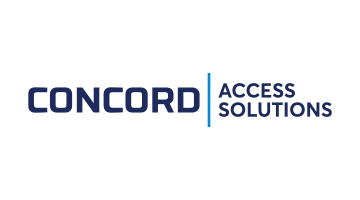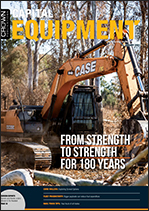 On the cover: In 2021, CASE Construction Equipment entered the South African market through the acquisition of multiple entities in the industry by CNH Industrial. This has enabled South African customers to purchase directly from the global CASE factory line through CASE Construction’s own OEM main distribution branches. With a sprawling network of dealers spread across the country, CASE Construction Equipment’s on-the-ground support ensures their customers always have easy access to the parts and services they need, making them a true partner in their success. CASE Construction Equipment also recently showcased and launched the V-series Backhoe Loader, which has catapulted CNH as the market leader in Backhoe Loader sales in South Africa.
On the cover: In 2021, CASE Construction Equipment entered the South African market through the acquisition of multiple entities in the industry by CNH Industrial. This has enabled South African customers to purchase directly from the global CASE factory line through CASE Construction’s own OEM main distribution branches. With a sprawling network of dealers spread across the country, CASE Construction Equipment’s on-the-ground support ensures their customers always have easy access to the parts and services they need, making them a true partner in their success. CASE Construction Equipment also recently showcased and launched the V-series Backhoe Loader, which has catapulted CNH as the market leader in Backhoe Loader sales in South Africa.
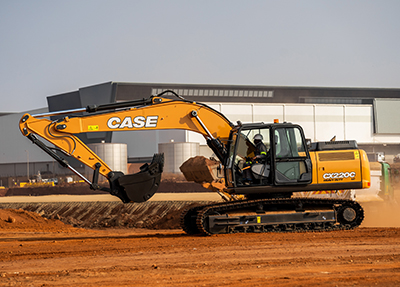 Additionally, CASE is set to expand its heavy line product portfolio to include a full range of 50T track-type hydraulic excavators and wheel loaders in 2023, which will be integrated with the new SiteWatch Telematics Technology, allowing real-time monitoring of product statistics, and putting customers back in the driver’s seat to ensure optimal profitability within their domain. For customers the merger of CNH and CASE in 2021 has unlocked a new world of possibilities for South African end-users, granting them direct access to the global CASE factory line through the company’s main OEM branches in Gauteng, Cape Town, KwaZulu-Natal, and the Eastern Cape. This strategic acquisition has solidified CASE Construction’s position as a market-dominating equipment giant. According to Tim Boshoff, National Retail Manager at CASE Construction Equipment, Southern Africa, “Our customers are the real boss, and we make sure to keep them happy. In 2022, we nailed a Customer Satisfaction Index score of 80% among our South African customers across various industries, including agriculture, construction, mining, and forestry. And let’s be real, who doesn’t love happy customers?” Strong roots In 2022, CASE Construction Equipment celebrated 180 years of making heavy metal dreams come true. “We pride ourselves on providing practical solutions to real-world problems on job sites. And we’ll go above and beyond to make sure our aftermarket support is top-notch, no matter where you are or what you’re using our equipment for,” says Boshoff. With lightning speed, CNH Industrial has rocketed to the top of the leader board in backhoe loader sales in South Africa. And the brand shows no signs of slowing down. CASE Construction offers more than just backhoe loaders, also supplies motor graders, track-type dozers, and skid steer loaders. In 2023, CASE Construction is set to broaden its heavy line product portfolio to include a full range of track-type hydraulic excavators and wheel loaders, all fully equipped with cutting-edge SiteWatch Telematics Technology.
Additionally, CASE is set to expand its heavy line product portfolio to include a full range of 50T track-type hydraulic excavators and wheel loaders in 2023, which will be integrated with the new SiteWatch Telematics Technology, allowing real-time monitoring of product statistics, and putting customers back in the driver’s seat to ensure optimal profitability within their domain. For customers the merger of CNH and CASE in 2021 has unlocked a new world of possibilities for South African end-users, granting them direct access to the global CASE factory line through the company’s main OEM branches in Gauteng, Cape Town, KwaZulu-Natal, and the Eastern Cape. This strategic acquisition has solidified CASE Construction’s position as a market-dominating equipment giant. According to Tim Boshoff, National Retail Manager at CASE Construction Equipment, Southern Africa, “Our customers are the real boss, and we make sure to keep them happy. In 2022, we nailed a Customer Satisfaction Index score of 80% among our South African customers across various industries, including agriculture, construction, mining, and forestry. And let’s be real, who doesn’t love happy customers?” Strong roots In 2022, CASE Construction Equipment celebrated 180 years of making heavy metal dreams come true. “We pride ourselves on providing practical solutions to real-world problems on job sites. And we’ll go above and beyond to make sure our aftermarket support is top-notch, no matter where you are or what you’re using our equipment for,” says Boshoff. With lightning speed, CNH Industrial has rocketed to the top of the leader board in backhoe loader sales in South Africa. And the brand shows no signs of slowing down. CASE Construction offers more than just backhoe loaders, also supplies motor graders, track-type dozers, and skid steer loaders. In 2023, CASE Construction is set to broaden its heavy line product portfolio to include a full range of track-type hydraulic excavators and wheel loaders, all fully equipped with cutting-edge SiteWatch Telematics Technology.
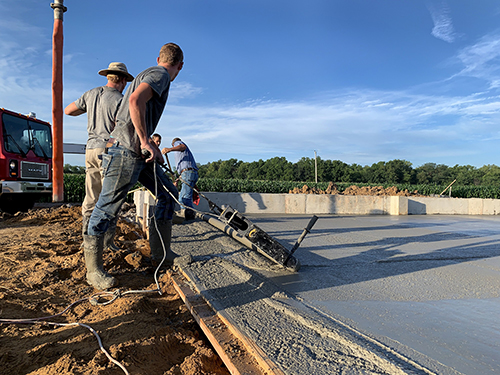 Exploring Screed Options: By carefully considering the screed types available, contractors can see maximum productivity from their investment when it comes to choosing the equipment that will, at the end, lay down the screed. This is especially true in the construction arena where screed is used as sidewalks or walkways in and among buildings. The most common screed categories include roller, truss, laser, power and hand screeds. Each screed has unique features that, when aligned with project goals, can improve ROI. Here is a breakdown of the features, benefits, and drawbacks of the most widely available screeds on the market today. Roller screeds broadly consist of a detachable pipe connected to a drive head with an extended handle for upright, ergonomic operation. These screeds are known for their minimal setup, low learning curve and the consistent, quality results they provide, with less reliance on the operator’s skill level. Roller screedsuse a spinning motion to move concrete, a method that reduces operator fatigue and allows for improved integration of aggregate throughout the pour compared to vibratory methods that cause the aggregate to settle. These screeds are versatile and can be used for a variety of pours, often up to 22-30 feet wide, depending on the power source. The roller screed’s detachable design also makes for a highly portable option when compared to bulkier and heavier screeds like a laser screed. Some manufacturers even offer linkable pipe sections to increase portability and versatility. General features like a 3-way adjustable and lockable handle for improved ease of operation and a kickstand to keep the drive head and handle out of the concrete allow crews to quickly adapt to various job site needs. Contractors have four different power options to choose from: battery, corded, hydraulic and gas-powered.
Exploring Screed Options: By carefully considering the screed types available, contractors can see maximum productivity from their investment when it comes to choosing the equipment that will, at the end, lay down the screed. This is especially true in the construction arena where screed is used as sidewalks or walkways in and among buildings. The most common screed categories include roller, truss, laser, power and hand screeds. Each screed has unique features that, when aligned with project goals, can improve ROI. Here is a breakdown of the features, benefits, and drawbacks of the most widely available screeds on the market today. Roller screeds broadly consist of a detachable pipe connected to a drive head with an extended handle for upright, ergonomic operation. These screeds are known for their minimal setup, low learning curve and the consistent, quality results they provide, with less reliance on the operator’s skill level. Roller screedsuse a spinning motion to move concrete, a method that reduces operator fatigue and allows for improved integration of aggregate throughout the pour compared to vibratory methods that cause the aggregate to settle. These screeds are versatile and can be used for a variety of pours, often up to 22-30 feet wide, depending on the power source. The roller screed’s detachable design also makes for a highly portable option when compared to bulkier and heavier screeds like a laser screed. Some manufacturers even offer linkable pipe sections to increase portability and versatility. General features like a 3-way adjustable and lockable handle for improved ease of operation and a kickstand to keep the drive head and handle out of the concrete allow crews to quickly adapt to various job site needs. Contractors have four different power options to choose from: battery, corded, hydraulic and gas-powered.
 Bigger payloads can reduce fuel expenditure: Fuel expenditure, which makes up to 80% of total operating costs and approximately 60% of the total cost of ownership, depending on the application, can be alleviated with the ability to carry morepayload to maximise the productivity and efficiency of a fleet. The UD Trucks Quon extra heavy truck range solves this problem by a reduction of weight in the physical truck that allows operators to carry more payload. Fewer trips mean less fuel is used. “The Quon is a highly productive range of vehicles optimised for the business needs of today, and tomorrow,” explains Reytjie Laubscher, Managing Director of UD Trucks Lichtenburg. The Quon GW26 460 - TT HR, for instance, has a low tare weight of 8 418kg. This is achieved by using disc brakes and high-tensile steel rails for the main frame to reduce vehicle weight. In addition, the reduced height of the main frame cross section further reduces weight while maintaining strength, to further improve the Quon’s loading performance. Laubscher explains that this, for instance, means that with a reduced tare weight, an operator can now typically transport a 36.5-ton load of cargo legally using an interlink with a twin bin side tipper trailer. “There is an increase in payload of about 700kg on average on the new generation Quon High Roof Truck Tractor compared to any other competitor in the market. This is the ideal set-up for fleet owners that specialise, for instance, in the coal transport industry,” says Laubscher. Improved ease of loading, bodybuilding efficiency and smoothness at creeping speeds for approaching loading docks, also reflect UD Trucks’ commitment to boosting productivity for fleet owners. Quon’s air suspension features an increased adjustment range. This enables optimal height adjustment for loading docks and connecting the trailers, with an adjustable width of +140 mm upward from the neutral position. The uneven load adjustment function automatically adjusts any lateral differences in height on trucks, which improves handling when loading from the side of the truck.
Bigger payloads can reduce fuel expenditure: Fuel expenditure, which makes up to 80% of total operating costs and approximately 60% of the total cost of ownership, depending on the application, can be alleviated with the ability to carry morepayload to maximise the productivity and efficiency of a fleet. The UD Trucks Quon extra heavy truck range solves this problem by a reduction of weight in the physical truck that allows operators to carry more payload. Fewer trips mean less fuel is used. “The Quon is a highly productive range of vehicles optimised for the business needs of today, and tomorrow,” explains Reytjie Laubscher, Managing Director of UD Trucks Lichtenburg. The Quon GW26 460 - TT HR, for instance, has a low tare weight of 8 418kg. This is achieved by using disc brakes and high-tensile steel rails for the main frame to reduce vehicle weight. In addition, the reduced height of the main frame cross section further reduces weight while maintaining strength, to further improve the Quon’s loading performance. Laubscher explains that this, for instance, means that with a reduced tare weight, an operator can now typically transport a 36.5-ton load of cargo legally using an interlink with a twin bin side tipper trailer. “There is an increase in payload of about 700kg on average on the new generation Quon High Roof Truck Tractor compared to any other competitor in the market. This is the ideal set-up for fleet owners that specialise, for instance, in the coal transport industry,” says Laubscher. Improved ease of loading, bodybuilding efficiency and smoothness at creeping speeds for approaching loading docks, also reflect UD Trucks’ commitment to boosting productivity for fleet owners. Quon’s air suspension features an increased adjustment range. This enables optimal height adjustment for loading docks and connecting the trailers, with an adjustable width of +140 mm upward from the neutral position. The uneven load adjustment function automatically adjusts any lateral differences in height on trucks, which improves handling when loading from the side of the truck.
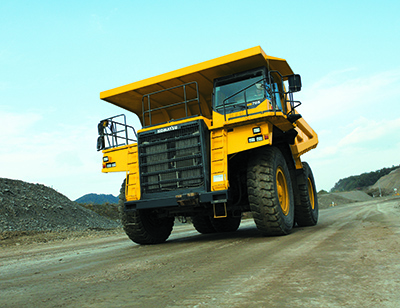 Changing the narrative of gender bias in the mining sector: The importance of gender diversification is becoming clear and changing the narrative around women in mining is an essential component of this. Prisma Training Solutions completed training of an all-women group of 14 women, who were taught and licensed to drive Komatsu HD785 dump trucks, a skill that has traditionally been the domain of male workers. The legacy of the mining industry highlights the disparity between men and women. In the past, gender roles were assigned where males were fit for work while women stayed at home to tend to family life. However, this has changed dramatically, and women have found their strength in the workforce, mining included. The challenge that is often faced, however, is that pre-existing stereotypes persist. There is still a belief that women are not strong enough to perform some jobs, as well as patriarchal attitudes and bias against women, who are frequently judged on their gender and not their job performance. “There is an ongoing perception that women are physically incapable of many of the technical or more physical roles in mining, and typically women in the mining industry have thus been assigned softer roles. It is becoming increasingly evident, however, that women are not only capable of performing jobs that were considered men’s jobs, but that they bring a whole new perspective to the roles that can be immensely valuable,” says Carol Brandt, Metallurgy Training Manager at Prisma.
Changing the narrative of gender bias in the mining sector: The importance of gender diversification is becoming clear and changing the narrative around women in mining is an essential component of this. Prisma Training Solutions completed training of an all-women group of 14 women, who were taught and licensed to drive Komatsu HD785 dump trucks, a skill that has traditionally been the domain of male workers. The legacy of the mining industry highlights the disparity between men and women. In the past, gender roles were assigned where males were fit for work while women stayed at home to tend to family life. However, this has changed dramatically, and women have found their strength in the workforce, mining included. The challenge that is often faced, however, is that pre-existing stereotypes persist. There is still a belief that women are not strong enough to perform some jobs, as well as patriarchal attitudes and bias against women, who are frequently judged on their gender and not their job performance. “There is an ongoing perception that women are physically incapable of many of the technical or more physical roles in mining, and typically women in the mining industry have thus been assigned softer roles. It is becoming increasingly evident, however, that women are not only capable of performing jobs that were considered men’s jobs, but that they bring a whole new perspective to the roles that can be immensely valuable,” says Carol Brandt, Metallurgy Training Manager at Prisma.
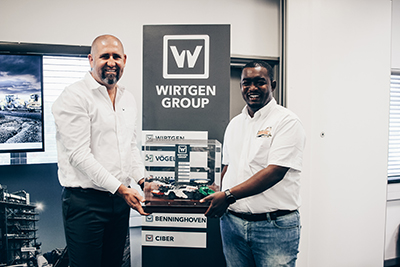 Southern Africa OEMs take on 2023: Having last congregated with its dealers a few years ago, Wirtgen Group South Africa held its annual dealer conference at the end of November 2022. Following the appointment of new regional dealers in recent years, the conference was largely aimed at bringing the new distributors up to speed with the Wirtgen Group strategy and processes, explained Heinrich Schulenburg, MD of Wirtgen Group SA. With all group OEMs represented – including Wirtgen, Hamm, Kleemann, Ciber Benninghoven and Vögele – the conference was also a perfect platform for dealers to learn more about the new product and technological developments from the various brands. “In recent years, we have appointed new dealers and the conference allowed us to introduce them to our processes and new focus. The new approach to our business will help them identify additional markets to exploit, thus providing them with tools to generate additional turnover and profits,” says Schulenburg. Waylon Kukard, sales manager at Wirtgen Group SA, says one of the key focus areas was to educate dealers about the wide market reach and opportunities offered by the complementary ranges within the Wirtgen Group. “After our interactive three-day conference, our dealers now understand that Wirtgen is a lot bigger than just one or two products that we are traditionally known for. They are starting to realise that there are more growth opportunities available when you focus on the whole product portfolio – all the way from road construction to surface mining, and everything in between,” says Kukard.
Southern Africa OEMs take on 2023: Having last congregated with its dealers a few years ago, Wirtgen Group South Africa held its annual dealer conference at the end of November 2022. Following the appointment of new regional dealers in recent years, the conference was largely aimed at bringing the new distributors up to speed with the Wirtgen Group strategy and processes, explained Heinrich Schulenburg, MD of Wirtgen Group SA. With all group OEMs represented – including Wirtgen, Hamm, Kleemann, Ciber Benninghoven and Vögele – the conference was also a perfect platform for dealers to learn more about the new product and technological developments from the various brands. “In recent years, we have appointed new dealers and the conference allowed us to introduce them to our processes and new focus. The new approach to our business will help them identify additional markets to exploit, thus providing them with tools to generate additional turnover and profits,” says Schulenburg. Waylon Kukard, sales manager at Wirtgen Group SA, says one of the key focus areas was to educate dealers about the wide market reach and opportunities offered by the complementary ranges within the Wirtgen Group. “After our interactive three-day conference, our dealers now understand that Wirtgen is a lot bigger than just one or two products that we are traditionally known for. They are starting to realise that there are more growth opportunities available when you focus on the whole product portfolio – all the way from road construction to surface mining, and everything in between,” says Kukard.
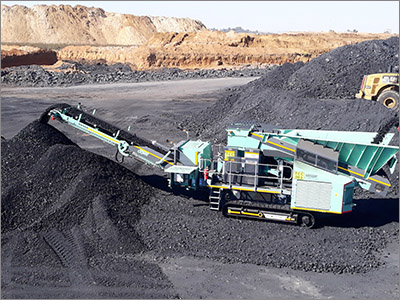 A mobile coal-crushing solution: In the highly competitive world of mobile coal crushing, Pilot Crushtec’s DoppiaTrac DR400 is a triumph of local design and engineering, with a decade of success in the field. “We designed the DR400 from the ground up to give us the flexibility to produce a truly great crushing solution,” says Jorge Abelho, director technical support at Pilot Crushtec. “It has proved itself through its combination of throughput, reliability and economy.” Indeed, it is Africa’s only locally manufactured, fully mobile double-roll crusher – capable of averaging production rates from 300 to 350 tonnes per hour and reaching 400 tonnes per hour. Its ability to reduce the generation of fines is thanks to the double-roll crusher. While a horizontal shaft impact crusher creates more coal fines due to impact energy, the double-roll crusher forces material through a constant gap. “The crusher uses just enough energy to break the material down to the size of the gap,” explains Pilot Crushtec sales engineer Ben Armitage. “The DR400 generates less than 5% of 0 to 6 mm fines, compared to around 12% created by impact crushers – depending on coal hardness and crushing ratios.” The DR400 boasts a large hopper that is readily fed by loaders or excavators. To increase the average production rate, the unit can be interlocked as part of a crushing train. Connected with a Metso LT106 jaw crusher, the two units can communicate to synchronise the feed-rate. This optimises throughput by automatically adjusting the rate of material moving between the machines. The on-board hydraulic rock breaker on the Metso LT106 also allows oversize material to be quickly broken, avoiding blockages and preventing downtime. Crushing efficiency is enhanced by feeding material into the crushing chamber at exactly the same speed that the drums are spinning. This minimises attrition and friction, even at high throughput rates. “The safety features on the DR400 ensure that it is compliant with demanding safety protocols applied by mining companies,” says Armitage.
A mobile coal-crushing solution: In the highly competitive world of mobile coal crushing, Pilot Crushtec’s DoppiaTrac DR400 is a triumph of local design and engineering, with a decade of success in the field. “We designed the DR400 from the ground up to give us the flexibility to produce a truly great crushing solution,” says Jorge Abelho, director technical support at Pilot Crushtec. “It has proved itself through its combination of throughput, reliability and economy.” Indeed, it is Africa’s only locally manufactured, fully mobile double-roll crusher – capable of averaging production rates from 300 to 350 tonnes per hour and reaching 400 tonnes per hour. Its ability to reduce the generation of fines is thanks to the double-roll crusher. While a horizontal shaft impact crusher creates more coal fines due to impact energy, the double-roll crusher forces material through a constant gap. “The crusher uses just enough energy to break the material down to the size of the gap,” explains Pilot Crushtec sales engineer Ben Armitage. “The DR400 generates less than 5% of 0 to 6 mm fines, compared to around 12% created by impact crushers – depending on coal hardness and crushing ratios.” The DR400 boasts a large hopper that is readily fed by loaders or excavators. To increase the average production rate, the unit can be interlocked as part of a crushing train. Connected with a Metso LT106 jaw crusher, the two units can communicate to synchronise the feed-rate. This optimises throughput by automatically adjusting the rate of material moving between the machines. The on-board hydraulic rock breaker on the Metso LT106 also allows oversize material to be quickly broken, avoiding blockages and preventing downtime. Crushing efficiency is enhanced by feeding material into the crushing chamber at exactly the same speed that the drums are spinning. This minimises attrition and friction, even at high throughput rates. “The safety features on the DR400 ensure that it is compliant with demanding safety protocols applied by mining companies,” says Armitage.





